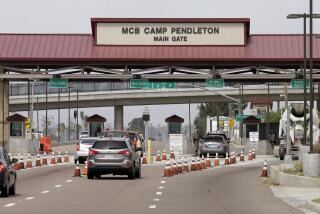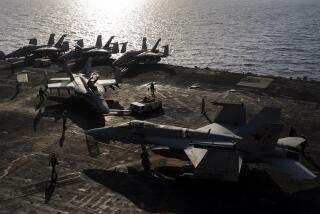Collision at Sea Adds to List of Navy’s Mishaps
- Share via
SAN DIEGO — Since Oct. 29, when the crash of a Navy airman making his first aircraft carrier landing killed five, to the collision Sunday of the San Diego-based destroyer Kinkaid, the last two weeks have been a nightmare of Navy men killed at sea and in plane crashes.
The death of the Kinkaid’s navigator, Lt. Sean Michael McPhee, 24, of Santa Rosa, came as the destroyer collided with a merchant vessel in the pre-dawn darkness off Malaysia. It brought the year’s toll to 102 Navy personnel killed during training and standard operating procedures, the highest in the decade, officials said Monday.
Last year, 63 men were killed, and there were 69 major accidents. So far in 1989, there have been 67 major accidents involving loss of life or more than $1 million damage to Navy property.
But Navy officials say that, despite the recent string of accidents, their personnel are well-trained and maintain a high regard for safety.
“The readiness of today’s Naval forces has never been better,” said Adm. C. A. H. Trost, chief of Naval Operations, in a statement released Monday. “The Navy faces an unforgiving and inherently dangerous environment at sea. Despite uncompromising attention to safety procedures and exhaustive training standards, the dangers are always present; and, despite our best efforts, accidents do happen.”
Officials point out that this year’s death toll includes 47 sailors killed in the explosion aboard the battleship Iowa last April.
“We do not consider the Iowa an accident,” said. Lt. Greg Smith, a Navy spokesman. The Navy determined that an explosion aboard the Iowa was an “act of suicide” by Gunner’s Mate Clayton Hartwig, who died in the blast. Although officials include the Iowa deaths in their tally, the other fatal incidents occurred during training exercises or routine operations, he said.
Smith and other officials say the accidents and deaths during the last few weeks are unrelated and do not reflect a trend. Since 1984, an average of 70 Navy personnel have died each year in duty-related incidents.
The collision involving the Kinkaid, one of five accidents in recent days, was part of “what has been a bad couple of weeks for the Navy,” said Cmdr. David Dillon, a spokesman for the commander of the Pacific Fleet in San Diego.
The 563-foot Kinkaid, which sailed through the Strait of Malacca on its own power, reached Singapore waters Monday about nine hours later than officials had expected, Dillon said. The 8,350-ton destroyer was met by tugs that escorted it to the Sembawang Shipyard for repairs and investigation.
The Kinkaid has a crew of 20 officers and 297 sailors. The accident occurred about 240 miles northwest of Singapore when the destroyer and the Kota Petani, a 430-foot Panamanian-registry freighter, collided. The freighter had taken on a cargo in Singapore and was headed for the Middle East.
McPhee was killed as he rested in his berth. Five other Navy men were injured and four of them were taken to Mt. Elizabeth Hospital in Singapore, Dillon said.
To bolster morale among the crew, officials installed five telephones aboard the Kinkaid to allow sailors to call home--an unusual practice, officials said.
“The crew is working, working to get things back to normal. I have no idea how long that will take,” said Lt. Cmdr. David Cunningham, executive officer of the Kinkaid, reached by telephone aboard the ship in Singapore. “We’re doing everything possible to make life as normal as possible on board.”
Cunningham declined to describe the accident, saying: “An investigation is in process and, until that’s finished, we really can’t say anything. The investigators are already on board.”
Cunningham, a Kansas native, said he did not know whether the crew would wait for repairs to be finished or be sent elsewhere.
The Kinkaid was on its way from the Indian Ocean for a scheduled port call in Singapore when it collided with the freighter. The collision ripped a 15-by-56-foot hole above the waterline on the starboard side of the destroyer.
Officials do not know why the collision occurred. It happened at 5:19 a.m., and the skies were dark though clear, Dillon said. The sea conditions do not appear to have contributed to the accident, he said.
“The earth is covered with three-quarters water, and still ships collide,” Dillon said. “It’s unfortunate that all these accidents seem to be occurring in one short period of time.”
Officials with the Naval Safety Center will investigate each of the accidents that has struck the Navy this year, Navy spokesman Smith said. Excluding the explosion aboard the Iowa, “we are having our best year,” Smith said. This year, there have been 1.8 accidents for every 100,000 hours of flight, or the Navy’s safest flight rate ever, he said.
Officials do not expect to ease up the Navy’s training. Adm. Trost said training “on deployed ships and aircraft, at all times of the day or night, in varying environmental conditions and in realistic operational situations” has resulted in a “high state of readiness.”
Others say that Navy personnel are at lower risk than people in other occupations. In 1987, there were 49 deaths per 100,000 agriculture workers; 38 per 100,000 miners. During the same year, the rate was 12 deaths per 100,000 Navy personnel. These figures, however, involve a range of Navy personnel, from those with desk jobs to those working aboard ships. The Navy does not have statistics available for men whose jobs might place them at higher risk.
“On the whole, the (military) population as a group tend to be better educated than the population at large and more safety-oriented than the population at large,” said John Welmsley, a spokesman for USAA, an insurance company whose clients are 95% military.
But, although officials quote safety data, many confess privately to an uneasiness as the toll of accidents has climbed in the last two weeks:
- On Nov. 9, a Navy Reserve jet crashed into a Georgia apartment complex, killing two residents.
- On Nov. 1, nine sailors suffered smoke inhalation, and four were treated for burns after a boiler fire aboard the tanker Monongahela, about 500 miles west of Gibraltar.
- On Oct. 31, three sailors and a reported $4 million of non-nuclear missiles were swept overboard by a wave striking the aircraft carrier Eisenhower near Cape Hatteras, N.C. One sailor is presumed dead.
- On Oct. 30, a sailor fell overboard from the aircraft carrier Carl Vinson in the Pacific about 620 miles north of Wake island. He is presumed lost.
- On Oct. 30, a pilot dropped a 500-pound bomb on the guided missile cruiser Reeves in the Indian Ocean, causing minor injuries to five sailors.
- On Oct. 29, a training jet crashed aboard the aircraft carrier Lexington in the Gulf of Mexico, killing the pilot and four sailors aboard.
1987 FATALITIES IN MAJOR INDUSTRIES
TOTAL PER 100,000 Agriculture * 1,600 49 Mining and quarrying 300 38 U.S. NAVY 72 12 (w/o STARK attack) 25 5.8 Construction 2,200 35 Manufacturing 1,100 6 Transportation & utilities 1,500 28
* includes fishing and forestry
Source: National Safety Council
U.S. NAVY MAJOR ACCIDENTS & FATALITIES
TOTAL ACCIDENTS/MISHAPS FATALITIES 1984 118 64 1985 88 61 1986 96 56 1987 89 72 (37 on the Stark) 1988 69 63 1989 67 102 (47 on the Iowa)
A major accident/mishap is one that results in a fatality or $1 million damage. Source: U.S. Navy.
More to Read
Sign up for Essential California
The most important California stories and recommendations in your inbox every morning.
You may occasionally receive promotional content from the Los Angeles Times.









